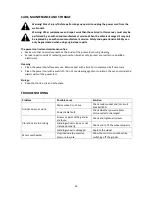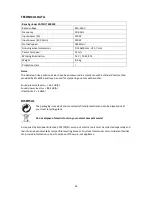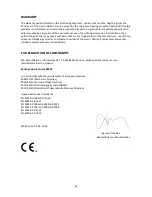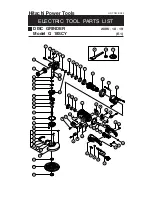
4. Power tool use and care
a)
Do not force the power tool. Use the correct power tool for your
application.
The correct power
tool will do the job better and safer at the rate for which it was designed.
b)
Do not use the power tool if the switch does not turn it on and off.
Any power tool that cannot be
controlled with the switch is dangerous and must
be repaired.
c)
Disconnect the plug from the power source and/or the battery pack from the power tool before
making any adjustments, changing accessories, or storing power tools.
Such preventive safety
measures reduce the risk of starting the power tool accidentally.
d)
Store idle power tools out of the reach of children and do not allow persons unfamiliar with the
power tool or these instructions to operate the power tool.
Power tools are dangerous in the hands
of untrained users.
e)
Maintain power tools. Check for misalignment or binding of moving parts, breakage of parts and
any other condition that may affect the power tool’s operation. If damaged, have the power tool
repaired before use.
Many accidents are caused by poorly maintained power tools.
f)
Keep cutting tools sharp and clean.
Properly maintained cutting tools with sharp cutting edges are
less likely to bind and are easier to control.
g)
Use the power tool, accessories and tool bits etc. in accordance with these instructions, taking into
account the working conditions and the work to be performed.
Use of the power tool for
operations different from those intended could result in a hazardous situation.
h)
Keep handle dry, clean and free from oil and grease.
Slippery handles do not allow for safe handling
and control of the tool in unexpected situations.
5. Service
a)
Have your power tool serviced by a qualified repair person using only identical replacement parts.
This will ensure that the safety of the power tool is maintained.
ADDITIONAL SAFETY RULES FOR BENCH
GRINDER
Wear eye
protection!
•
Do not use damaged or unshaped wheels.
•
The adjustment of the spark guard shall be made frequently, so as to compensate the wear of the
wheel, keeping the distance between the guard and the wheel as small as possible, and no greater
than 2 mm.
•
The adjustment of the work rest shall be made frequently, so as to compensate the wear of the
wheel, keeping the distance between the work rest and the wheel as small as possible, and no
greater than 2 mm.
•
Use wheels that have a bore exactly equal to the arbor of the grinder. Do not attempt to alter
an
undersized wheel to fit an arbor.
•
Do not overtighten the wheel nut.
•
Do not grind on a cold wheel. The grinding wheel should be started and run at idle speed for one
minute before applying the work.
•
Do not grind on the side of the wheel. Grind on the face of the wheel only.
•
Do not apply coolant directly to a grinding wheel. Coolant can weaken the bonding strength of the
wheel and cause it to fail.
28
Summary of Contents for SB0250
Page 2: ...2...








































